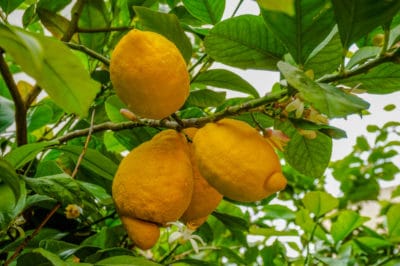Start With Size
To make caring for your lemon tree as easy as possible, choose one grafted onto a semi-dwarf rootstock. Typical sizes for the most widely grow semi-dwarf cultivars are:
- ‘Eureka’: 10 to 15 feet
- ‘Eureka Variegated Pink’: 8 to 12 feet
- ‘Ponderosa’: 8 to 12 feet
- ‘Improved Meyer’: 6 to 10 feet
- ‘Lisbon’: 12 to 15 feet
Standard-sized lemon cultivars top out at 25 feet, so you’ll really appreciate a smaller one when harvest time rolls around.
Consider the Climate
As subtropical plants, lemon trees grow in USDA plant hardiness zones 9 through 11. They don’t tolerate sub-freezing temperatures well. If possible, position your tree in a wind-sheltered spot with southern exposure. The best site would get reflected heat from a nearby wall, concrete patio or driveway.
Additional Site Requirements
To accommodate your mature tree, the planting site should be 8 to 10 feet in diameter, with well-draining, humus-rich soil. If your drainage isn’t the best, plant in a raised bed of equal parts soil and organic compost.
Expert gardener’s tip: Don’t plant on a lawn; lemon trees need deep, infrequent watering — not the regular, light sprinklings that most grass requires.
Planting Your Tree
Plant your lemon tree on an cool early morning between spring and fall. Keep the rootball shaded while working. Trim broken or encircling roots and center the tree in its hole. Backfill around the roots, tamping the soil lightly to eliminate air pockets. Water deeply to settle the soil.
Ongoing Care
Water your tree two or three times a week until its roots establish. Mound soil around it at the drip line, where rain falls from the ends of the branches to the ground. This DIY basin channels water to the roots until the soil mound eventually crumbles.
After your tree has put out 6 inches of vertical growth, reduce watering to once every other week (once weekly during dry spells). Preserve soil moisture and discourage weeds with a 3- to 4-inch layer of organic mulch. Just don’t pile it around the trunk.
Fertilizing
Fertilizing your lemon tree as soon as it begins sprouting new leaves with a granular, slow-release fertilizer formulated for citrus. Apply it three times during the growing season, with the last application no later than July. Fertilizing after that may encourage a late flush of frost-tender growth.
Spread the label’s recommended amount of granules evenly under the canopy, keeping them several inches from the trunk. Water well when you’re finished.
Pruning
Pinch the flowers and baby fruit off your tree in the first two years after planting, so it spends its energy on developing strong roots and branches.
Prune suckers sprouting below the scar where the top of your tree was grafted to its rootstock. Otherwise, they’ll engulf the tree and steal its water and nutrients. Also prune any dead, diseased or crossing branches.
To prune a branch, locate a thorn and leaf bud and make your cut at a 45-degree angle 1/4 inch above them. Soak your pruning tools for five minutes in a solution of 1 part bleach to 3 parts water before working.
Frost Protection
As soon as frost is in the forecast:
- Soak the soil around your tree so it retains its warmth.
- Drape a sheet or other large cloth over the tree. Plastic is also fine, if you remove fit when the sun is out to prevent leaf burn.
- Run holiday lights over and through the canopy and keep them on while temperatures are in the danger zone.
Pest Control
Treat mild aphid and leafminer infestations by pruning and disposing of the affected leaves.
For organic all-purpose control of soft-bodied pests including aphids, whiteflies, mealybugs, thrips, psyllids and soft scale, make a spray solution with:
- 1 teaspoon (5ml) natural liquid dish soap
- 1 teaspoon (5ml) chili powder
- 1 teaspoon (5ml) vegetable oil
- 1 tablespoon (15ml) of baking soda
- 1 quart (.95L) of water
At the first sign of infestation, spray the canopy until the liquid drips from both sides of the leaves. Rinse the tree after a few hours so the oil doesn’t harm the leaves. Repeat the treatment every three days until the pests are gone.
